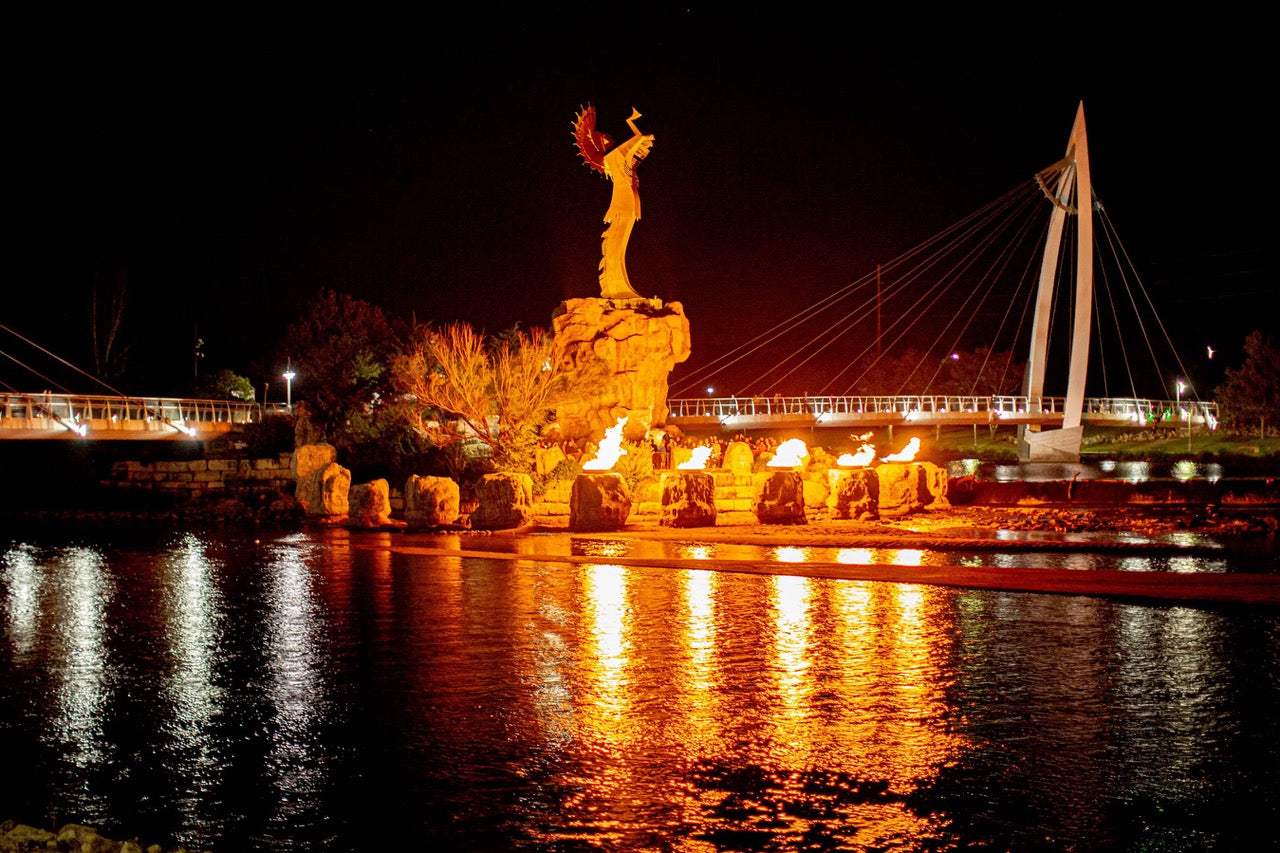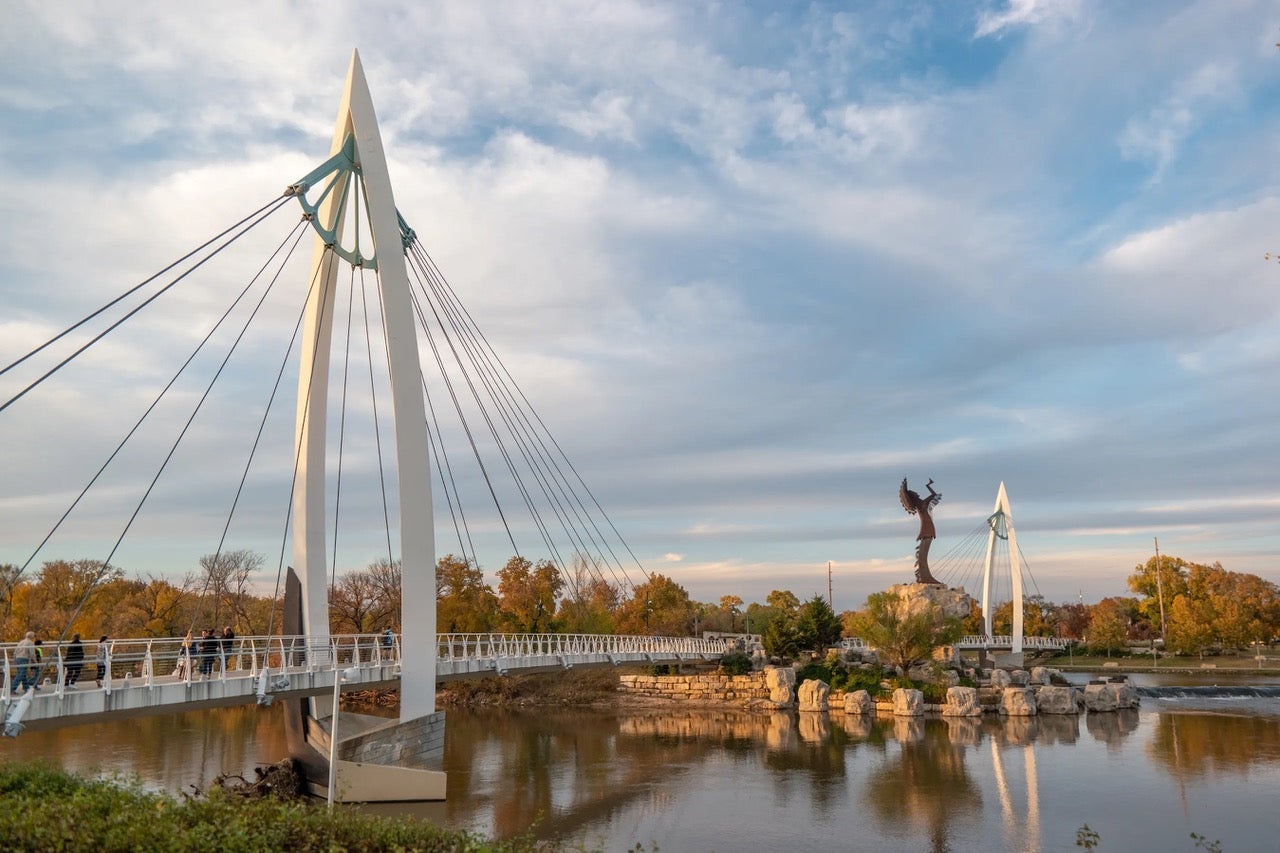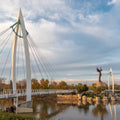Blackbear Bosin's 'Keeper of the Plains' Sculpture Celebrates 50 Years in Wichita
By Chadd Scott on
Wichita’s Keeper of the Plains sculpture celebrates 50 years with a daylong schedule of events May 18, 2024. Completed by Blackbear Bosin (1921–1980) and erected on May 18, 1974, the installation has become a symbol for the city and a tribute to the Native American tribes who continue gathering at the sacred site. The Keeper of the Plains stands at the confluence of the Big and Little Arkansas rivers in downtown with hands raised in supplication to the Great Spirit–a manifestation of Wichita’s enduring spirit.

Keeper of the Plains sculpture along the riverfront in Wichita. Photo Credit Visit Wichita.
Bosin refused payment for the Keeper, instead dedicating it to the city of Wichita and its people as a symbol of unity, resilience, and reverence for the land and its original inhabitants.
At the dedication ceremony, he said, “I sincerely hope that this sculpture will always be a reminder to all peoples that we all belong to the earth, our Mother, to the sun, our Father, and above all, to each other and to the Great Spirit.”
The Keeper monument takes on a dramatic glow each night at 9:00 PM during Daylight Savings Time and 7:00 PM during Standard Daylight Time as firepots surrounding its base – the Ring of Fire – are lit for 15 minutes – weather permitting. The firepots symbolically complete a sacred hoop of the four elements: earth, wind, water, fire.
The Ring of Fire was added as part of an eight-year, $20 million river corridor improvement project completed in 2007 that also saw the sculpture placed atop a 30-foot pedestal.

Keeper of the Plains sculpture surrounded by the Ring of Fire. Photo credit Trevor Hawkin and Visit Wichita.
Blackbear Bosin
Blackbear Bosin was born in Oklahoma, moving to Wichita in 1940 and working for Beech Aircraft before joining the U.S. Marine Corps. He returned in 1946, spending the remainder of his life there.
He comes from Kiowa-Comanche heritage, with his Kiowa name, Tsate Kongia, meaning “blackbear.” He takes the name from his great-grandfather, a Kiowa chief.
The 5-ton, 44-foot-tall steel Keeper of the Plains was Bosin’s only structural project in a career renowned for painting. In 1950, 66 of his paintings were featured in a remarkable exhibition at the Smithsonian National Museum of Natural History in Washington, D.C.
Another of Bosin’s major commissions remains on view in Wichita at the Drury Plaza Hotel Broadview, formerly the Hotel Broadview. In 1959 he was asked to create a mural for the property’s ballroom. The 1,500-square-foot artwork can still be found there today less than a mile from Keeper.
Mid-America All-Indian Museum
The best place in Wichita to see Blackbear Bosin’s artwork and learn more about him comes at the Mid-America All-Indian Museum which he helped found. It is located right next to Keeper of the Plains and houses the largest collection of his work.

Keeper of the Plains sculpture in Wichita. Photo credit Wasim Muklashy Photography and Visit Wichita.
A permanent exhibit, “Tsate Kongia: Walking in Two Worlds, the Life of Blackbear Bosin,” displays paintings, photographs, vintage film footage, live audio tapes made by Bosin, and interviews with people close to him.
Between the Museum and Keeper, visitors pass through gardens featuring one of Bosin’s most famous artworks, Prairie Fire, created in 1953 and published in “National Geographic” magazine in 1955.
The gardens pay tribute not only to Bosin, but also Woody Crumbo (1912–1989), another greatly celebrated and influential Native American artist. Crumbo was born to a Potawatomi/French mother and German/American father, but both died when the artist was young, and he went on to live with Creeks. His artworks are infused with Creek culture.
Crumbo attended the American Indian Institute in Wichita for his final two years of high school, then Wichita University – now Wichita State University – from 1933 to 1936 before transferring to the University of Oklahoma. At just 21 years old, he was appointed Director of Indian Art at Bacone College in Muskogee, Oklahoma, the only institution of higher learning exclusively for Indigenous people at the time.
Keeper of the Plains 50th Anniversary Celebration
This year’s anniversary is a city wide celebration featuring the “Party for the People” and will include a free, family-friendly gathering including a powwow, Native performances, food, fireworks and free admission to the Mid-America All-Indian Museum.
“Party for the People” event schedule:
- 7:00 AM | Volunteer river cleanup
- 8:00 AM | Park Run
- 11:00 AM | Re-dedication Ceremony & Opening Remarks
Commemorate the 50th anniversary with a ceremony honoring the iconic Keeper statue.
- 11:30 AM | City Crew Event
Engage with the local city crew in a special event showcasing community collaboration.
- 1-5:00 PM | Outdoor Festival & Live Entertainment
A family-friendly gathering featuring Native performances, free museum admission, and outdoor games.
- 2-8:00 PM | Indoor Powwow
- 8:00 PM | Floatin' On The River - Glow Tour
Experience the enchanting Glow Tour on the river, a mesmerizing spectacle.
- 9:00 PM | Fireworks Show



